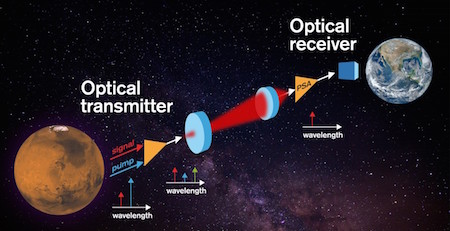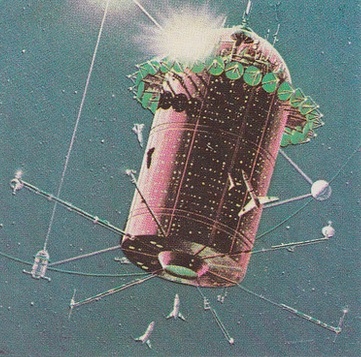Science Fiction
Dictionary
A B C D E F G H I J K L M N O P Q R S T U V W X Y Z
New Technology For Interplanetary Communication

Travel to Mars? Travel back to the Moon? Go to asteroids? We need better communications for this 21st century space travel!

(Using light signals rather than radio)
Credit: Yen Strandqvist/Chalmers University of Technology
When we return to the Moon and place our first footsteps on Mars, we will want not only scientific data but live video feeds, high-resolution images, and even tweets from the astronauts. Imagine trying to stream gigabytes of data between Earth and Mars. Even the most sophisticated radio network isnít capable of that level of bandwidth. While NASA is working on modern radio designs, radio communication might not meet all our needs.A new study looks at an alternative. It uses visible light rather than radio. While visible light can carry more data due to its shorter wavelengths, it also scatters more readily and loses fidelity over a shorter distance. To overcome this, the team proposes combining the signal with a second reference signal. The whole thing is then passed through a non-linear optical fiber, which generates a third signal known as an idler wave. All three of these are then amplified and sent on their way. On the other end, the signals are captured and processed. Because the idler wave depends on the other two signals, it can be used to reconstruct the original signal without much data loss. In lab experiments, the team reached a data-rate of more than 10Gb/s, which is ten times higher than current technology.
Communication in outer space is one of the pet projects put forward by communications engineer - and science fiction writer - George O. Smith in his 1942 story QRM - Interplanetary.
The Venus Equilateral Relay Station was a modern miracle of engineering if you liked to believe the books. Actually, Venus Equilateral was an asteroid that had been shoved into its orbit about the Sun, forming a practical demonstration of the equilateral triangle solution of the Three Moving Bodies. It was a long cylinder, about three miles in length by about a mile in diameter...
(From Venus Equilateral Station)This was the center of Interplanetary Communications. This was the main office. It was the heart of the Solar System's communication line, and as such, it was well manned. Orders for everything emanated from Venus Equilateral.
Earlier still, Harry Gore Bishop wrote this in his 1907 story On the Martian Way:
Nor is it necessary to again tell how sweating, heat-blistered engineers at every interplanetary radiograph station on three planets, stood by their generators until they were carried out unconscious, speeding up their machines, to the calls of set-faced operators for higher voltage, as they hurled radiogram after radiogram out into space, under a pressure that damaged receivers on boats as far away as Jupiter but which failed to excite the wornout and leaky induction coils of the Columbia's instruments.
(Read more about the Interplanetary Radiograph Station)
Via UniverseToday.
Scroll down for more stories in the same category. (Story submitted 10/23/2020)
Follow this kind of news @Technovelgy.| Email | RSS | Blog It | Stumble | del.icio.us | Digg | Reddit |
Would
you like to contribute a story tip?
It's easy:
Get the URL of the story, and the related sf author, and add
it here.
Comment/Join discussion ( 0 )
Related News Stories - (" Space Tech ")
Will Space Stations Have Large Interior Spaces Again?
'They filed clumsily into the battleroom, like children in a swimming pool for the first time, clinging to the handholds along the side.' - Orson Scott Card, 1985.
Reflect Orbital Offers 'Sunlight on Demand' And Light Pollution
'I don't have to tell you about the seven two-mile-diameter orbital mirrors...'
Chrysalis Generation Ship to Alpha Centauri
'This was their world, their planet ó
this swift-traveling, yet seemingly moveless vessel.' - Nat Schachner, 1934
The First Space Warship For Space Force
'Each of the electrical ships carried about twenty men...' - Garrett P. Serviss, 1898.
Technovelgy (that's tech-novel-gee!) is devoted to the creative science inventions and ideas of sf authors. Look for the Invention Category that interests you, the Glossary, the Invention Timeline, or see what's New.
Science Fiction
Timeline
1600-1899
1900-1939
1940's 1950's
1960's 1970's
1980's 1990's
2000's 2010's
Current News
Leader-Follower Autonomous Vehicle Technology
'Jason had been guiding the caravan of cars as usual...'
Golf Ball Test Robot Wears Them Out
"The robot solemnly hit a ball against the wall, picked it up and teed it, hit it again, over and again...'
Boring Company Vegas Loop Like Asimov Said
'There was a wall ahead... It was riddled with holes that were the mouths of tunnels.'
Rigid Metallic Clothing From Science Fiction To You
'...support the interior human structure against Jupiterís pull.'
Is The Seattle Ultrasonics C-200 A Heinlein Vibroblade?
'It ain't a vibroblade. It's steel. Messy.'
Roborock Saros Z70 Is A Robot Vacuum With An Arm
'Anything larger than a BB shot it picked up and placed in a tray...'
A Beautiful Visualization Of Compact Food
'The German chemists have discovered how to supply the needed elements in compact, undiluted form...'
Bone-Building Drug Evenity Approved
'Compounds devised by the biochemists for the rapid building of bone...'
Secret Kill Switch Found In Yutong Buses
'The car faltered as the external command came to brake...'
Inmotion Electric Unicycle In Combat
'It is about the size and shape of a kitchen stool, gyro-stabilized...'
Grok Scores Best In Psychological Tests
'Try to find out how he ticks...'
PaXini Supersensitive Robot Fingers
'My fingers are not that sensitive...'
Congress Considers Automatic Emergency Braking, One Hundred Years Too Late
'The greatest problem of all was the elimination of the human element of braking together with its inevitable time lag.'
The Desert Ship Sailed In Imagination
'Across the ancient sea floor a dozen tall, blue-sailed Martian sand ships floated, like blue smoke.'
The Zapata Air Scooter Would Be Great In A Science Fiction Story
'Betty's slapdash style.'
Thermostabilized Wet Meat Product (NASA Prototype)
There are no orbiting Michelin stars. Yet.

